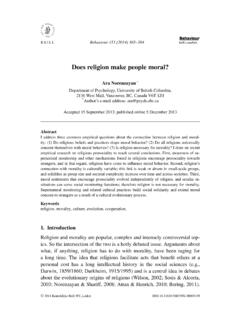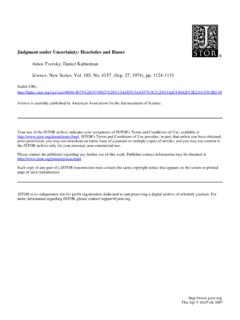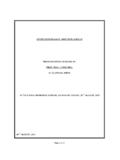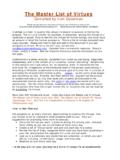Transcription of The Meaning Maintenance Model: On the Coherence of …
1 PersonalityandSocialPsychologyReview Copyright@2006by 2 0 0 6V. o l .1 0 .N o . 2 . 8 8 - 1 1 0 LawrenceErlbaumAssociates. Inc. The MeaningMaintenanceModel: On the Coherenceof SocialMotivations StevenJ. Heine TbavisProulx Department of Psychology University of British Columbia Kathleen D. Vohs Department of Marketing and Logistics Management Unive rsity of Minne sota The Meaning maintenancemodel (MMM) proposesthat people hat,ea needfor mean- ing; that is, aneedto perceiveeventsthrougha prism ofmental representations ofex- pected relations that organizestheir perceptions of the world. Whenpeople's senseof Meaning is threatened,they reaffirm alternative representationsas a $'al to rego'n Meaning -a process termedfluid to the model ,people can reaffirmmeqningin domainsthat are dffirent from the domainin which the threatoc- curred. Evidencefor fluid compensationcan be obsened following a varien* of psy- chological threats, including most especially threats to the self, such as self-esteem threats,feelings of uncertainQ, interpersonal rejection, and mortali4' ple respondto thesediverse threats in highly similar ways, which suggeststhat o range of psychological motivations are expressionsof a singular impulse to generate and maintain a senseof meqninR.
2 nostalgia for unity , that appetitefor the absolute ple, what would happenif they were confronted with a illustrates the essential impulse of the human black queen of hearts?How would they perceive this drama. card, and how would this card affect their existing Albert Camus,An Absurd Reasoning playing card paradigm? Bruner and Postman(1949) designedan experiment In1949, JeromeBruner and Leo Postmanpublished to test this very their experiment,most par- a study in the Journal of Personaliry entitled, "On the ticipants began by ignoring the novel relationships perception of incongruity: A paradigm." According to among features, or more precisely, they failed to see Bruner and Postman,people maintain mental represen- them. Instead,they automatically revised their percep- tations of expected relations, paradigms, that in turn tions of the anomalouscardssuchthat the suitsandcol- regulate their perceptions of the world.
3 Consider the ors matched their mental representationsof expected paradigmfor playing cards:52 cards,4 suits,2 colors, relations (black hearts were seen as red). After re- and a wide anay of associatedfeaturesthat are demar- peatedpresentations, however,most participantsgrad- cated into distinct would happen to ually becameawareof the anomalousfeatures,and un- this paradigm if people encountereda card that did not prompted, beganto revise their playing card paradigms fit into any of their recognized categories?For exam- to account for these newly related , abofi l0%oof participants found themselvestrappedin a kind of paradigm purgatory, whereby they recog- This research was funded by grants from NIMH (R01 nized that the cards with which they were presented MH060155-O1A2)and SSHRC (410-2001-0097,410-2004-0795). had unexpectedfeatures,but they could not articulate to Steven J.
4 Heine and by support from SSHRC and the CanadaRe- searchChair Council to Kathleen D. Vohs. the odd ,they could not re- We are especially grateful to Edith Chen, Ian Hansen, Ara vise their existing paradigm to accommodate the Norenzayan,Mark Schaller,Brandon Schmeichel, Azim Shariff, and more curious, these same participants members of the Culture and Self Lab for comments on an earlier often experienced acute personal distress, with one participant exclaiming "I can't make the suit out what- draft. Correspondenceshould be sent to Steven J. Heine, Department of Psychology,2136 West Mall, University of British Columbia, ever it is. It didn't even look like a card that time. I. Vancouver,BC V6T 124 : don't know what color it is now or whetherit's a spade 88. Meaning MAINTENANCEMODEL. or a heart. I'm not even sure what a spadelooks like. are Meaning -makers,driven to make connections,find My God!
5 " ( ). signals in noise, identify patterns,and establishassoci- If we were to grant that some of Bruner and Post- ations in places where they may not inherently exist. man's (1949) study participants experienced actual People are Meaning -makersinsofar as they seemcom- distress in this situation, one wonders why anyone pelled to establish mental representationsof expected should be troubled when presentedwith a black queen relations that tie together elements of their external of hearts. Why care about playing cards?We propose world, elementsof the self, and most importantly, bind that the uneaseexperiencedby participants in Bruner the self to the external world. When elements of per- and Postman's study reveals a much broader concern ceived reality are encounteredthat do not seem to be that underlies a diverse array of human motivations. part of people's existing relational structures,or that This uneasereflects a need for meanins.
6 Resist relational integration, these inconsistent ele- "feeling of the absurd," a disconcert- ments provoke a ing sense of fundamental incongruity that motivates Western Existentialism people to re-establisha senseof normalcy and coher- encein their lives. We begin our investigationof a needfor meaningby considering the literature that has most directly ex- plored this concept. A number of philosophers,whom The Meaning Maintenance model we term the Westernexistentialists,have arguedthat a key element of the human condition is a never-ending At first glance, mattersof Meaning may seemsuffi- pursuit of Meaning that is the goal of this ciently esoteric and tenuous as to lie outside the pur- search is a fundamentally relational mode of being. view of experimental psychology. However, such con- Kierkegaard (1843/1997, 184811997), for example, cerns are being put to rest by the chorus of voices wrote extensivelyon the mannerin which the self is ex- across multiple subdisciplines who have taken to periencedin relation to that which lies outside the self.
7 Studying Meaning -related phenomena. Echoes of "a Camus's nostalgiacan be heard in researchon sche- He suggestedthat the self is experiencedas relation thatrelatesitselfto itself, and in relatingitselfto itself, mata ( ,Markus, 1977),worldviews (Thompson&. relates itself to another" (p. 351). Heidegger (19531 Janigan, 1988), assumptiveworlds (Janoff-Bulman, 1996) expandedon thesenotions to such an extent that 1992), domainsof the known (Peterson,1999),a sense he would no longer use the word sef in any manner, of Coherence (Antonovsky, 1919), unity principles preferring the expressionDa-sein (being there) to ex- (Epstein,1981),and aboveall, terror managementthe- press a being so connectedto its environment that any ory ( ,Pyszczynski,Greenberg,& Solomon,2004;. perceived discrimination was mere illusion. Camus Solomon, Greenberg,& Pyszczynski,1991) and the (1955) would later survey the relational themesof the new science of experimental existential psychology existential literature and extract as its central obsession ( , Greenberg,Koole, & Pyszczynski,2004).
8 The "the nos- commonality among these diverse lines of researchis a universalinclination toward what he termed talgia for unity :" a belief that all reality comprises a an attempt to articulate how humans strive to create single, interconnectedwhole. and maintain order,certainty,and value in light of chal- Regardless of whether the world is a relational lenges and abruptions in their endeavoursto do so. whole, Camus (1955) suggestedthat the desireto per- We propose an overarching model that parsimoni- ceive reality in such a manner, to both discover and ously integrates the diverse literatures on mean- "the ing-making, as well as the literatures on self-esteem construct relations represented essentialimpulse of the human drama" (p. 13). Camusreiterateda line of Maintenance , uncertainty reduction, affrliative mo- existential thought by claiming that all cultural endeav- tives, and terror management theory.
9 We term this ors-philosophy, science,art, and religion-are mani- model the Meaning Maintenance model (MMM), and festationsof the universal human needto relate all ele- use it to make three central claims that are addressed ments of perceived reality into a single, unified, and developedover the courseofthis article. cohesiveframework of expectedrelationships. The first of these claims is an expansionof a claim It was Camus'(1955) contentionthat, for the Wesr that has been made by psychologists for decadesand ern existentialistsl, Meaning is relation. Human beings philosophers for centuries (Aristotle, 198'7: Baumeister, 1991; Freud, l930ll99I; Heidegger, 1953/1996; James, l9ll/1997; Kierkegaard 1848/. rAlthough we have highlighted here the arguments of the West- 1997): Meaning is relation This is to say, Meaning is em existentialists,we are not proposing that a desire to perceive real- what links people,places,objects,and ideasto one an- ity as a relational whole is peculiar to Westernthought.
10 Rather, simi- other in expected and predictable ways. Because we lar arguments are evident in the literatures on Buddhism, Taoism, and Hinduism, and we submit that a nostalgia for unity is character- take Meaning , relation, and association to be synony- istic ofrelieious sentiments more senerallv. mous in this context, we will use these words inter- 89. HEINE,PROULX,VOHS. changeably,suchthat Meaning is the expectedrelation- In simpleterms,meaningis what connectsthingsto ships or associationsthat human beings construct and other things in expectedways-anything and any way impose on their worlds. We further propose that there that thingscanbe what connects existsa seriesof basic realmsin which peopleseekto the people,places,andthingsaroundoneself:ham mers discover or apply Meaning . People seekcoherentrela- to nails,cold to sno% mothersto daughters,or dawn to tions within the external world, within themselves,and the rising connectselementsof the self: between themselvesand the external world.













